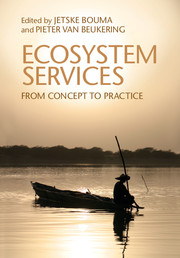Book contents
- Frontmatter
- Contents
- About the authors
- Part I Introduction
- Part II Measuring ecosystem services
- 2 The role of biodiversity in the provision of ecosystem services
- 3 A traits-based approach to quantifying ecosystem services
- 4 Mapping ecosystem services
- Part III Valuing ecosystem services
- Part IV Paying for ecosystem services
- Part V Governing ecosystem services
- Index
- Plate section
- References
4 - Mapping ecosystem services
from Part II - Measuring ecosystem services
Published online by Cambridge University Press: 05 February 2015
- Frontmatter
- Contents
- About the authors
- Part I Introduction
- Part II Measuring ecosystem services
- 2 The role of biodiversity in the provision of ecosystem services
- 3 A traits-based approach to quantifying ecosystem services
- 4 Mapping ecosystem services
- Part III Valuing ecosystem services
- Part IV Paying for ecosystem services
- Part V Governing ecosystem services
- Index
- Plate section
- References
Summary
Introduction
In Chapter 3, the variation in ecosystem processes and functions was described using the plant functional trait approach. Due to variability in plant functional traits and other environmental conditions, as well as variation in human influence on ecosystems, the supply of ecosystem services is not homogeneously distributed across space. Besides spatial variation in the supply of ecosystem services, spatial variation in socioeconomic conditions makes the demand of ecosystem services dependent upon location as well. To understand the role of this spatial variation many ecosystem service assessments use observations, measurements, and models to create ecosystem service maps. Especially in the last couple of years an exponential increase has been observed in research, papers, and reports focused on mapping of ecosystem services. Ecosystem services can be mapped using various methods, of which applicability depends upon data availability, scope of the study, and time constraints. Regulating services are most commonly mapped, followed by provisioning services. The most frequently studied individual ecosystem services are climate regulation and food production (Martínez-Harms and Balvanera, 2012), and when multiple ecosystem services are mapped food production is almost always included (Crossman et al., 2013). Moreover, these studies vary in their scale from the global to the local level, vary in the type and number of ecosystem services incorporated, and map supply, demand, or a combination of both.
- Type
- Chapter
- Information
- Ecosystem ServicesFrom Concept to Practice, pp. 65 - 86Publisher: Cambridge University PressPrint publication year: 2015
References
- 3
- Cited by



